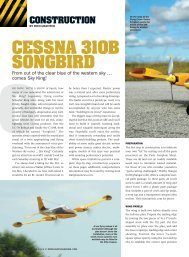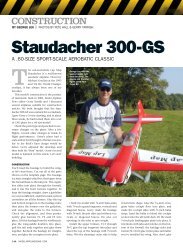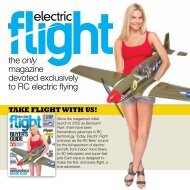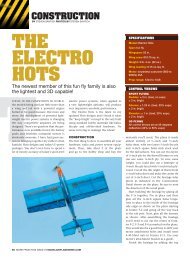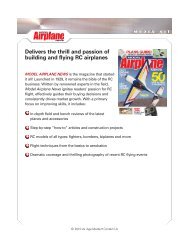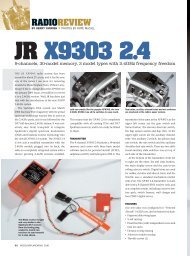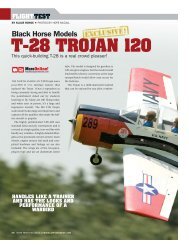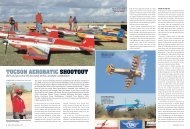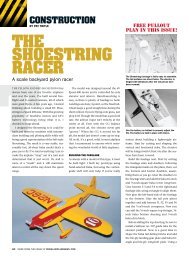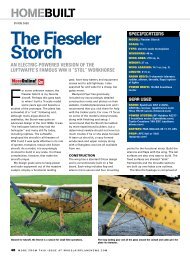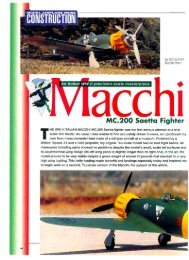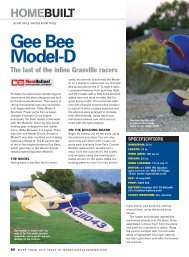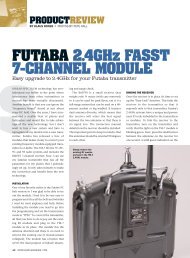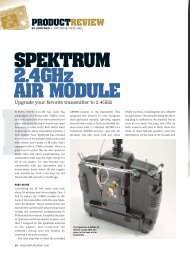You also want an ePaper? Increase the reach of your titles
YUMPU automatically turns print PDFs into web optimized ePapers that Google loves.
WHAT DO YOU GET?<br />
When I opened the box, I found a nicely<br />
fabric-covered, sport-scale Fokker Dr.l.<br />
When I looked through the contents of<br />
the box, I found that it included the<br />
plane, a dummy engine kit, machine<br />
guns, a painted fiberglass cowl, vinyl<br />
decals and a very complete-looking set of<br />
hardware. I could no longer control my<br />
enthusiasm, so I got busy at once! Within<br />
40 minutes of opening the box, I had an<br />
assembled triplane sitting on its wheels.<br />
ASSEMBLY<br />
To make sure I got it right, I began by<br />
reading the included instructions. As 1<br />
stated before, there really is not a tremendous<br />
amount of work involved in getting<br />
this plane ready to fly. I began by hinging<br />
and installing the ailerons and elevators.<br />
The hinges were among the few parts not<br />
included in the package. I chose to use<br />
medium Robart hinge points.<br />
The kit includes all of the necessary linkages to<br />
assemble the control system. I devised my own<br />
method of hooking up the elevator-control surfaces.<br />
The Fokker comes with some cable for a pull/pull<br />
control system on the rudder, but I elected to use<br />
Nyrod instead.<br />
5O MDDEL AIRPLANE NEWS<br />
a^ssjy<br />
The triplane's wings<br />
all come in one piece<br />
and can be easily<br />
attached with the supplied<br />
metal bolts. The<br />
cabane struts and interplane<br />
struts are also<br />
formed and ready to bolt<br />
into place with small<br />
L-brackets and screws.<br />
The landing-gear wire is<br />
already bent to shape; all<br />
you have to do is insert<br />
the wires into the<br />
mounting slots in the<br />
bottom of the fuselage<br />
and into the sub-wing fairing between the<br />
wheels and then secure them with the<br />
supplied straps and screws.<br />
The instruction sheet was a bit unclear<br />
about how to install the tailskid; it simply<br />
said to install the tailskid and spring with<br />
the supplied bungee. A quick call to the<br />
folks at Arizona Model Aircrafters<br />
cleared everything up. The tailskid<br />
should be installed with the supplied<br />
angle brackets and screws. Next, attach<br />
the hooks to either side of the fuselage<br />
and then attach the spring to the skid<br />
by running the bungee through it and<br />
looping it around the hooks. Arizona<br />
Model Aircrafters did inform me that I<br />
had received an early version of the<br />
model and that the directions have<br />
since been modified.<br />
ENGINE INSTALLATION<br />
This is the only part of the assembly<br />
that might be difficult for a beginner. I<br />
elected to use an O.S. .52 4-stroke<br />
engine in my plane. Because this is a<br />
The Fokker<br />
was designed<br />
for both electric<br />
and glow<br />
power;<br />
I chose to<br />
install this O.S.<br />
.52 4-stroke.<br />
The size of the<br />
plane and the<br />
number of<br />
wings may<br />
tempt you to<br />
install a larger<br />
engine. Resist<br />
the urge!<br />
good-size plane with a lot of wings, it took<br />
a great deal of willpower to resist the urge<br />
to install something larger. I suggest that<br />
you also resist this urge.<br />
The plane is designed for either electric<br />
or glow power, but glow fliers will need to<br />
slightly modify the model. You must<br />
enlarge the hole in the firewall so that the<br />
4-stroke carburetor can extend back<br />
through the firewall—a requirement if the<br />
engine is to fit inside the cowl. Laminate<br />
the two '/4-inch plywood engine mounts<br />
together. While they set, enlarge the center<br />
hole of the cowl to fit your engine and<br />
mount the cowl on the plane.<br />
Next, set the fuselage upside-down,<br />
tape the engine mount into place and<br />
mark the exact location of the engine on<br />
the mount. Drill your mount holes, attach<br />
the engine to the mount and then epoxy<br />
the mount/engine assembly into place,<br />
making sure to center the engine's crankshaft<br />
in the cowl hole. It actually sounds<br />
more complicated than it is.<br />
At this time, I modified the plane to



